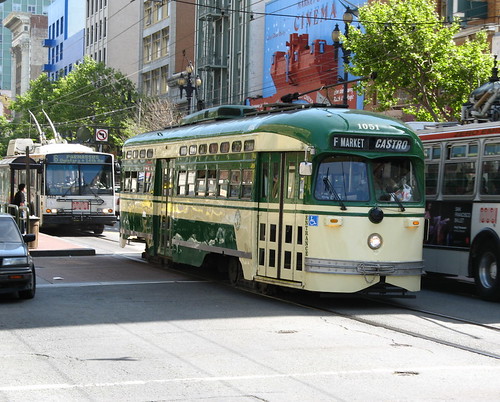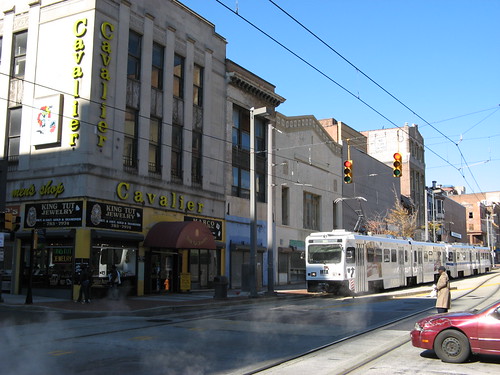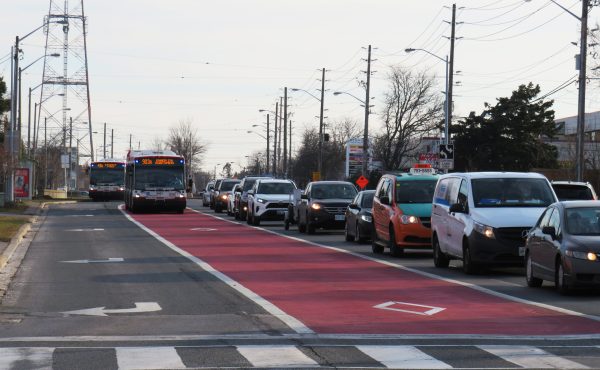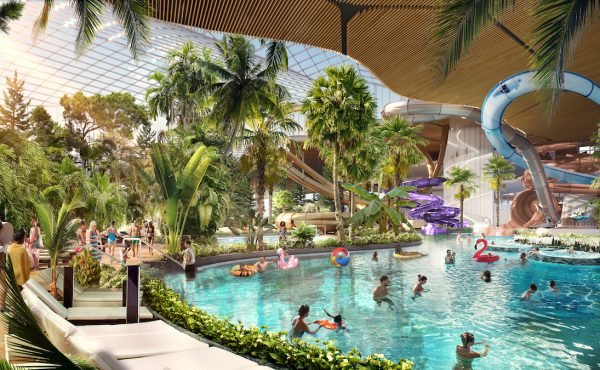
Los Angeles Metro Gold Line, Pasadena, California.
The light rail renaissance that has taken place across North America has taken a few interesting directions since 1978, when what is considered the first of these new light rail systems, Edmonton’s, opened. The boom continued through the 1980s and 1990s, but has slowed down, with fewer cities building new lines or extending existing ones.
There are three basic categories of light rail systems now in existence in Canada and the United States. The first of these is the legacy streetcar system, such as those in Boston, Philadelphia, Pittsburgh, Newark and San Francisco. In these cities, a small “core” streetcar network survived because buses were unsuitable replacements for their remaining systems – all featured lengthy tunnel or subway sections, such as Boston’s pioneering 1897 streetcar subway, or the tunnels under local mountains in Pittsburgh and San Francisco. San Francisco has expanded its legacy system to include the new T-Third Line. Modernized and often extended, these act more like rapid transit routes than your friendly neighbourhood streetcar, with names like Newark City Subway, Green Line, or MUNI Metro.

PCC on Market Street, part of San Francisco’s legacy street railway.
The second type is the modern rapid transit light rail system, for which most were built in the 1980s and 1990s. Light rail trains mostly run in exclusive rights-of-way or centre reservations, with minimal street running. The closest of these systems to Toronto is the Buffalo Metrorail, where light rail trains run in a subway for most of their route, and emerges to the surface in a transit mall downtown (it was to be part of a multi-branched system with lines to Tondawanda and the North Campus of the University of Buffalo, but budget cuts and suburban opposition scuttled these). Other examples include Calgary, San Diego (two other early pioneers), Baltimore, and St. Louis. Los Angeles is also actively building new light rail lines to augment is subway, many retracing the routes of the once-grand Pacific Electric network.

A modern light rail train in downtown Baltimore.

An ex-Toronto PCC in Kenosha.
Finally, there’s the new trend of operating short streetcar circulators as tourist attractions and/or downtown shuttles. Examples include Memphis, Tampa, Little Rock, and of course, Kenosha, Wisconsin. Most of these streetcar lines use real or replica heritage streetcars, such as PCCs or Birneys. Some of these routes have been effective as a catalyst of downtown renewal. They often cost less than half than of a “real” light rail system to build and start-up ($20-35 million per mile, compared to $50-60 million for a light rail line).
More cities are joining this latter group, including Albuquerque, Cincinnati, Kansas City, and Miami, who see these streetcars as more than a toonerville trolley.
Many of these proposals would use modern vehicles, rather than vintage or replica cars, using the experience of the Portland Streetcar (which connects to the regional MAX light rail) as a model. Indeed, Charlotte, North Carolina, is now building a light rail system several years after opening a downtown streetcar. According to a recent article in the Urban Land Institute magazine (Jeffrey Spivak, Streetcars are Back, January 2008), these modern streetcars are shorter (with a capacity of one-third less per car), and slower compared to many modern light rail vehicles. These short routes are easier to get support taxpayer support for, but have the potential for becoming the starting point for a much larger network.
Compared to all of these other cities, Toronto’s experience is unique, though it comes closest to that of San Francisco. Currently, Toronto does not have a modern light rail system, its system is based completely on a legacy street railway that did not have unique characteristics that prevented complete abandonment, such as a streetcar subway. With frequent stops, surface running, and by connecting shopping, residential areas, tourist attractions and other modes of transport in the downtown area, Toronto’s current streetcar system has many of the same functions as the new streetcar lines in the US.
Tomorrow, I will investigate more closely what the lessons are for Toronto from this latest spurt of streetcar construction (yes, there is a lot that American cities can teach us), and the implications as we embark on a new streetcar/light rail building era in the next decade.




5 comments
nice article sean,
but I don’t see how any of this relates to toronto where there isn’t any real vision or plan for a sustainable transit system.Take for example the new lrt on the waterfront that serves exhibition place but will be nowhere near where it can be utilized by people.Except of course from union station to the grounds and from etobicoke to the cne grounds.Liberty village will have no transportation whatsoever except for “maybe a bus” or not!Front street will continue to be devoit of any future plans for lrt.Just a small example of “where will it be built?”.We keep looking to other cities for solutions .Are we that stupid in this city that we still don’t have a clue what to do?Maybe a graduate from one of our universities has the answer!
Linking both Liberty Village and Etobicoke to Union Station with a single line would be impractical. Liberty Village deserves its own line. A line that fulfills one purpose is better than a line that fails to fulfill two.
Yes, nice perspective – thanks for it and the links.
The WWLRT as proposed doesn’t fulfill transit purposes particularly well – and there could be at least four of them:
– improved transit from Etobicoke-
– access to Ontario Place/lakefront
– serving Liberty Village
– serving other new devilopment in the Railway Lands
– improved alt transit along the King/Queen corridor
I know the better transit from Etobicoke is debatable but astoundingly enough, I dug through the WWLRT EA from 1993 and it even says within the EA that it’s not worthwhile p. ES-14 “Therefore, it is not considered cost effective to construct an LRT in this section* unless it is constructed as part of a new transit line along the Front St/Railway corridor between the downtown and the Queensway”
the * is along the north bank between Dufferin and Roncesvalles.
Other folks like Steve Munro are now weighing in about calling for a new EA/corridor analysis. As there’s a small $700,000,000+ price tag/commitment with the WWLRT – and the Union Station entry needs a rebuild with it c. $150M – in theory we should be squeezing those multi-millions better as it could mean a bus fleet or enough streetcars to keep the service along King/Queen useful.
The EA processes have been broken – the FSE EA still hasn’t looked at obvious transit options like GO transit, nor the harms to two transit systems after four? years of asking for an Individual EA, and the WWLRT’s own EA cuts up what we’re supposed to cheer – and both of them have been unable (for a variety of reasons including Pantalone’s power) to truly think of transit priority – including along Front St., which also has potential for having a good link to Weston via the tracks.
Steve Munro’s site has more: I know people can get tired of my being stuck on a near-billion of Waterfront Transport Follies (WTF – tx A).
But I’m not a NIMBY here in East York, I have always wanted to spend big on effective transit, and I’ve been changing my mind on the Front St. transitway idea put out to contrast the road. Yes, a Front St. transit line along Front St. Dufferin into the core/Union with a bridge over the tracks west of Bathurst, and a stop at the Ex/GO/Liberty area. But have the line go over the railtracks west of Dufferin on a transitway bridge that GO buses could also use and push along the Lakeshore road corridor in some way to Etobicoke.
New term: blindp.
One more reference city – Seattle, which is building both a “streetcar” and a “light rail” network.
It will be very interesting to see which kind of system Toronto is aiming for, as arguments could be made for any of the three network types based on the hodgepode of initiatives that dribble out of TTC headquarters. I personally favour the LRT model for the major lines, compelemented by new “streetcar” circulator routes downtown. It would not be too hard to magine a couple circular routes that would benefit tourists and downtowners alike…
Very good article, Sean. Another system to watch out for in the next 20 years will be Denver’s. They are committing to a very impressive hub-and-spoke operation that will use the old Union Pacific terminal as a sort of ‘central station’. From there, six or seven LRT lines will eventually radiate out, and there will be an in-station connection to heavy rail commuter trains. You can see the whole setup very clearly on Windows Live Local’s Bird’s Eye photos.